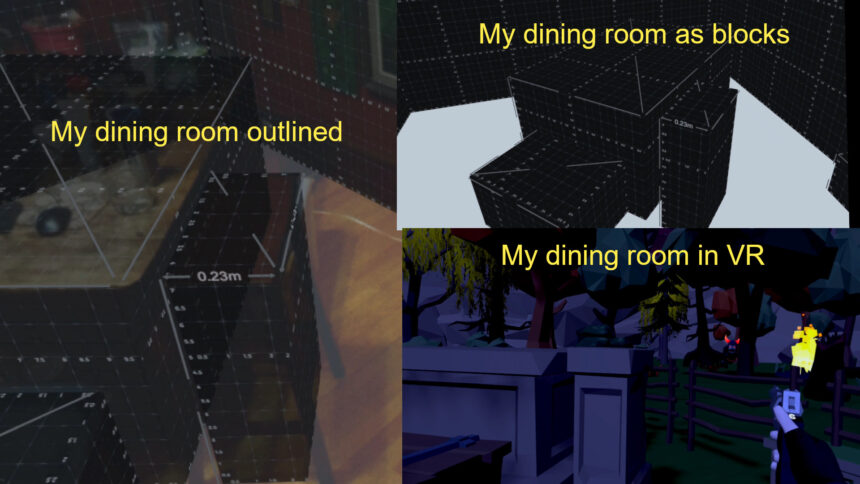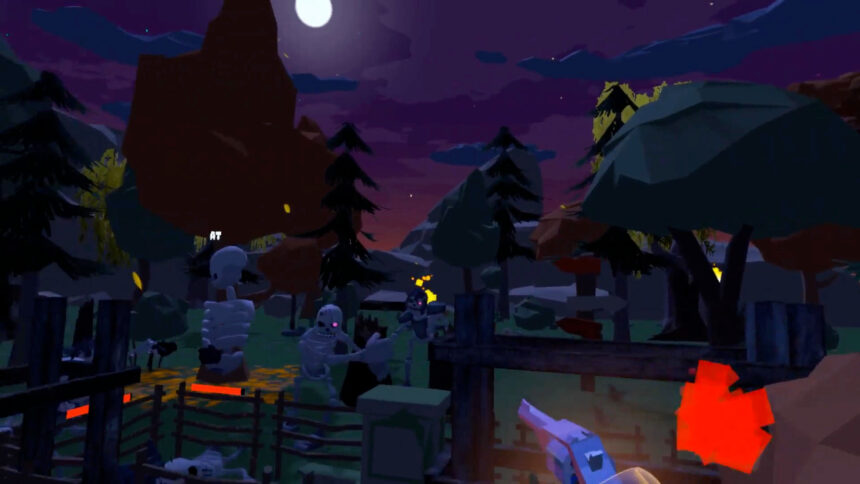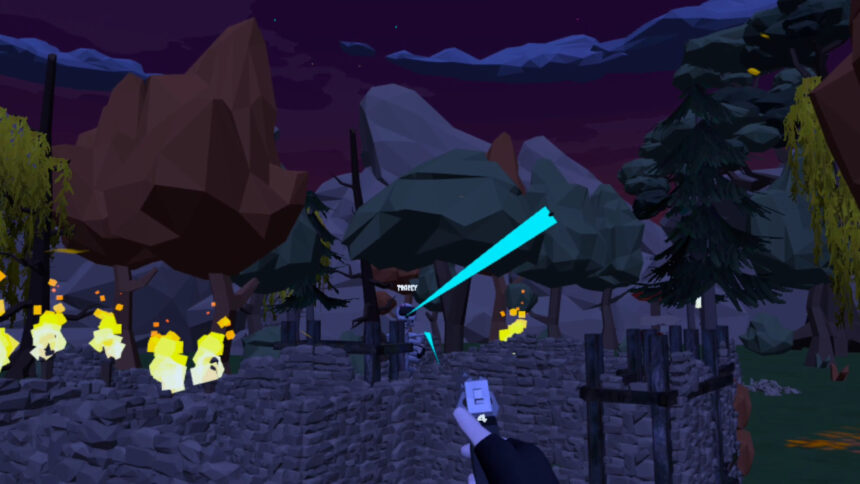Creepy monster battle with friends: Quest XR game maps your rooms

House Defender is a Quest XR game that recreates your room in VR, then connects it to other players' rooms for a unique and frantic multiplayer battle against an ever-increasing horde of spooky monsters.
House Defender is the reverse of other mixed reality games, like FPS Enhanced Reality, which makes it seem that armed intruders have entered your home. Instead of bringing virtual objects into the real world, my household items are converted into tombs, columns, and headstones. My walls are reduced to short fences, opening a view of a misty graveyard.
I'm in VR but can sit on a bench that looks like a tombstone or lean on a table that has become a crate. Space is warped as well, since each player is in their own room, possibly separated by hundreds of miles, but the rooms connect in the game, separated only by a short fence. It's a clever use of VR.
There's also an AR mode that shows your real furniture in VR. In AR mode, the Quest 2's monochrome passthrough might be preferable to the Quest Pro's color mixed reality view, which is a little distracting in House Defender's well-crafted, virtual gamespace. It's best to play in VR mode.
Room mapping is super quick
When I first launched House Defender, I was guided to map my room which was visible via the Quest's passthrough camera. The process is one of the easiest I've ever tried. I switched my guardian off (a developer mode feature), but you can use a roomscale guardian.
I place my controller in a corner of the room, squeeze the trigger, move to another corner, squeeze, and continue until I am back at the starting corner. I treat doors and windows as part of the wall. Height doesn't matter, and the room can have more than four corners, according to the architecture. My room is a standard square space, so the walls are mapped with four squeezes.
Next, I map furniture and other objects. The Quest knows where the floor is, so I only need to mark the upper corners of tables and chairs. I put the controller at a corner, squeeze, then mark two other upper corners. The obstacle is outlined, and the dimensions appear on top. I can remove the object if it's misaligned or change it into a shape that isn't flat. This is useful for plants, decorations, and anything I don't want to lean against.

House Defender turned my dining room into a spooky graveyard. | Image: Mixed
There's a fun transition of items in your room from outlines to blocks before transforming to match the scenery of the game. My table became a tomb, the bench turned into a tombstone, and a bookshelf became a rickety wooden fence.
Gameplay starts slow, turns frantic and fun
Playing solo was fun and allowed me to become familiar with the controls. I have a revolver that runs out of ammo too frequently, so I need to refine my accuracy. I shoot a small skeleton waddling over to me, then turn to find a demon battering my side fence. Larger skeletons, some with armor, join the fight.
The creatures come in waves, and I must find time to repair fences by holding a hand over a moving symbol. I can patch two fences simultaneously, but keeping both hands in the shifting repair zones is challenging.

House Defender makes you repair fences as monsters creep closer. Image: Mixed
Upgrades have a similar mechanism — hold a hand in the bonus zone for several seconds while monsters creep closer. Of course, you can reach in with one hand while shooting with the other.
Moving freely in my physical space while seeing the virtual world and obstacles makes the feeling incredibly immersive. I can walk around in a crowded room without worrying about bumping into an unseen object. I can crouch down and rest my arm on a tombstone that's actually a bench.
The real fun begins in multiplayer
In a multiplayer battle, you can see other players and their transformed rooms adjacent to your own as part of this creepy virtual graveyard. You can cooperate or battle other players. My wife joined me, and we prefer to work together, so we teamed up against the monsters.
She was upstairs in the bedroom, and I played in the dining room, which doubles as my workspace. The location of the guest room moves to a new position with each new game.

House Defender multiplayer mode connects joins two separate rooms. Image: Mixed
Despite playing in separate rooms on different floors of our house, inside the game, our playing zones were side by side. The alignment can change from game to game. Initially, my wife's playing area appeared to my right, but in the second game, it was at the front, a space that would actually be outside the dining room window. VR space doesn't have to obey physics!
I could shoot across her fenced area to help when a large number of creatures attacked her space, and she alerted me to monsters at my back and helped when my fence was about to fall.
For player versus player, I mapped out multiple rooms downstairs, a more complicated layout, so we wouldn't be shooting at each other across a fence. Even then, it wasn't as engaging as taking out skeletons, demons, and ogres.

House Defender has a player-versus-player mode which is best with several players or complex rooms. | Image: Mixed
House Defender is an entertaining and family-friendly game. You might tire of solo play, but multiplayer greatly adds to the fun. There's no gore, and the monsters are spooky in the style of Halloween fun, not scary like a zombie movie.
You can play with people worldwide or in another room in your home. House Defender is a unique take on XR gaming. This App Lab game is available for free and serves as a showcase for the developer 2sync's mixed reality framework. This form of shared virtual spaces was so engaging and immersive that I hope other developers look into 2sync's licensable SDK.
Note: Links to online stores in articles can be so-called affiliate links. If you buy through this link, MIXED receives a commission from the provider. For you the price does not change.